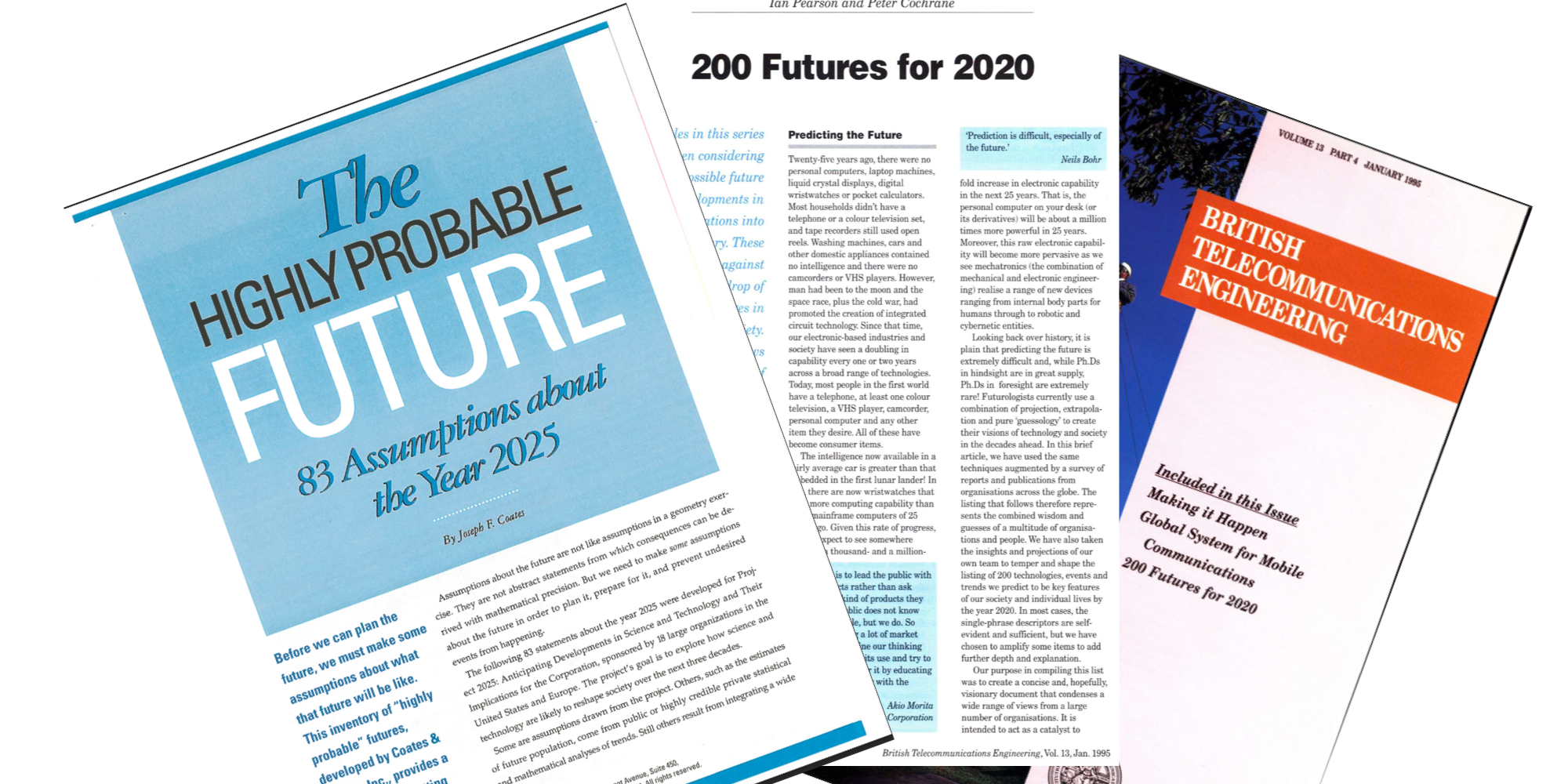Back From The Future: 1995's predictions of 2025 life
In 1995 three brave prognosticators set out to predict life in the 2020s. How did that work out for them?

1995: Steve Fossett became the first person to cross the Pacific Ocean in a balloon, OJ Simpson was acquitted of double murder and Coolio was living in a Gangsta's Paradise. The internet was something a mere 20 million people were using and most of them were doing so to the accompaniment of a screeching dial up modem. But some people were looking to the future. These brave prognosticators reached all the way through thirty years of time into what we now call erm... "now" to predict what life would be like in the mid-2020s.
If you're going to predict the future it's usually best to aim for a five to ten year time-frame. This makes your predictions close enough to excite people but far enough away that everyone's forgotten what you predicted by the time it doesn't pan out. But in 1995, Ian Pearson and Peter Cochrane penned an article in the exciting-sounding British Telecommunications Engineering journal entitled 200 Futures for 2020 and over at the World Future Society, Joseph F Coates gave us The Highly Probable Future: 83 Assumptions About The Year 2025.

The technology predictions of yesteryear are usually good for a laugh when the future they predicted stubbornly refuses to materialise on cue. Observe how many people are currently wearing their self-drying jackets and double neck ties as they zoom around in their flying Deloreans.
Some of the predictions are so bang on the money that they do make you wonder if a certain gull-winged sports car was involved. The articles predict a global fibre-based broadband network (the internet), widespread demand for computer skills in employment, a handheld electronic device with contrast equivalent to printed paper (Kindle Paperwhite etc) and widespread use of solar power for national and individual dwelling electricity.
In 1995 the world population was something like 5.7 billion people. At that time, Coates predicted a world population in 2025 of 8.4 billion people. The actual number is a little over 8.2 billion which is pretty close for a thirty year estimate. He was only out by approximately 1.2 Bangladeshes.
Interestingly, although the articles talk about social, environmental and medical developments, neither of them predicted a global pandemic or the rise of antimicrobial resistance. In fact, their predictions on this front are often related to genetics with widespread use of genome mapping, genetic screening and genetically-engineered treatments for physical and mental health problems. As with science fiction reflecting the prevailing trends of the time it was written, so these predictions reflect a time when the Human Genome Project was underway and it seemed that we would soon understand ourselves and our ailments as the expression of our individual DNA-encoded firmware.
Also missing is the explosion in mobile communication devices. The smartphone revolution means people all over the world now carry around with them a small computer that far exceeds the technical specifications of those that weighed down our desks in the mid-1990s. Cellular data services connect us like never before and, for better or worse, means that individuals have real-time global communication networks at their fingertips. The authors can probably be forgiven for not predicting that in the middle of the 2020s so many people would be spending their days mindlessly scrolling snippets of amusing, inane or downright inflammatory content from their fellow citizens.
Three interesting predictions about money are listed by Pearson and Cochrane :
- Global electronic currency in use
- Paper and coins largely replaced by electronic cash
- Paper cash used mainly for black market
Arguably Bitcoin fulfils the first bullet point and the second was rapidly accelerated by the pandemic and the desire for contactless payments. And while it's always been the case that untraceable cash has been the preferred payment system of criminals, in recent years electronic money in the form of cryptocurrencies has flourished in popularity for nefarious transactions. Small time drug dealers, international fraudsters, all the way up to nation states such as North Korea have seen the benefits of fast and largely anonymous transfers of money.
Of course the fun bit of looking back at these predictions is looking at the ones that were miles off target. "Passenger planes with speed beyond Mach four" and "superconductive magnetic levitation railways at 500 km/h" probably seemed like reasonable extrapolations of current trends at the time. Robots that do your housework have been a perennial favourite of science fiction predictions since at least the 1950s but so far the only real example is the Roomba vacuum cleaner. Likewise, regular manned missions to Mars and a human colony on the moon aren't any more realistic than they were back in the 90s.
The ever popular "more recreation and leisure time" also makes an appearance. Frequently predicted, probably since the start of the Industrial Revolution, it neglects to recognise that work expands to fit the time available to it. Increased efficiency seldom leads to a reduction in working time, it just means you can fit more work into the same number of hours. When was the last time your boss told you to take the rest of the week off because you'd finished all your work by Wednesday afternoon?
We can be grateful that the predictions of widespread nuclear contamination at a level almost double that of Chernobyl didn't come to pass, despite the reactor at Fukushima Daiichi Nuclear Power Plant giving it a good try in 2011. As for the prediction that "within the United States there will be a national, universal health-
care system", well, surely that can't have seemed very likely even at the time.
There's plenty more to cover from these articles which I'll be doing in future posts but if you'd like to read the articles yourself check the links below:
- The Highly Probable Future (pdf)
- 200 Futures for 2020 in British Telecommunications Engineering Volume 13 Part 4 (pages 312-318)





